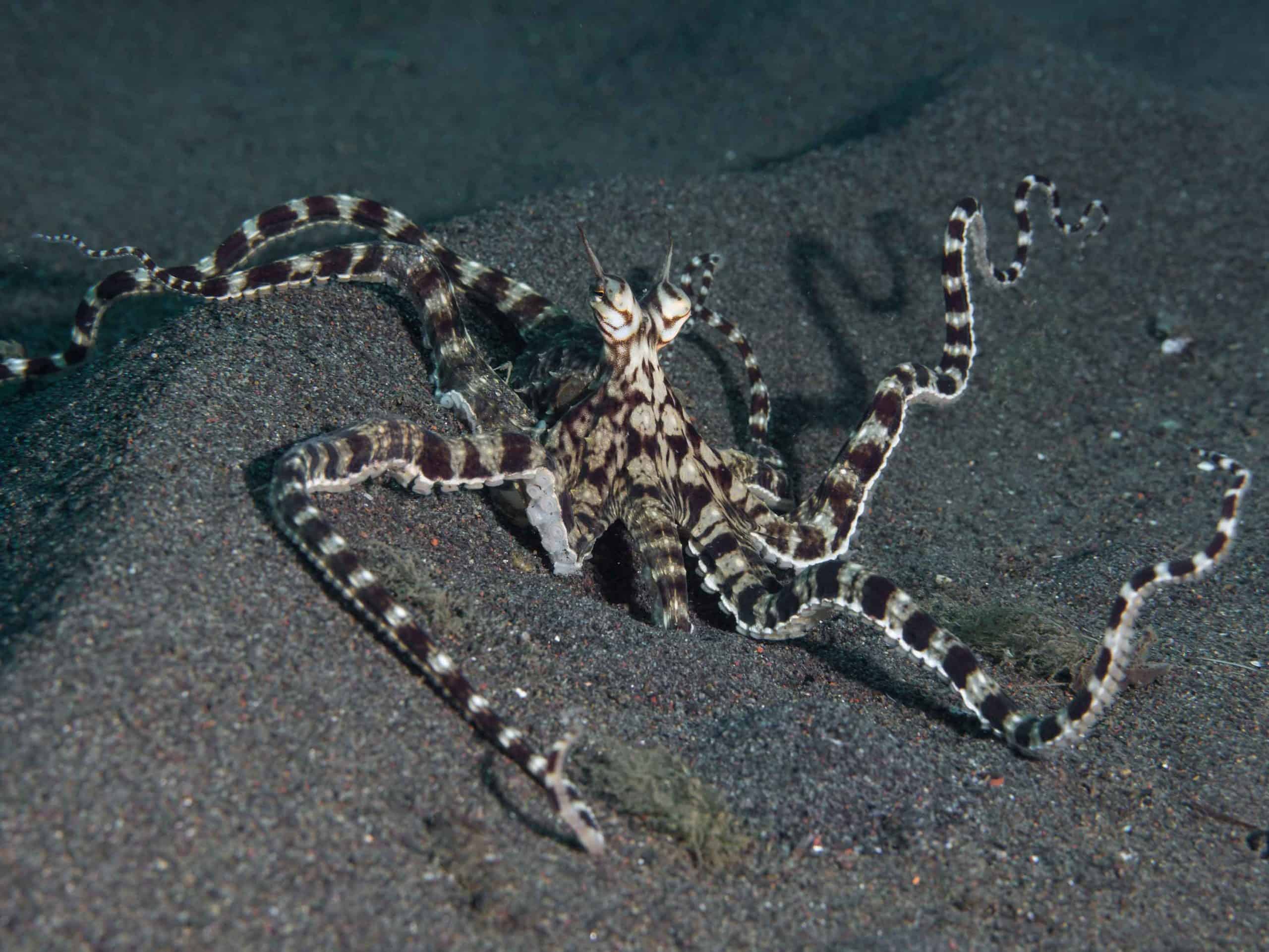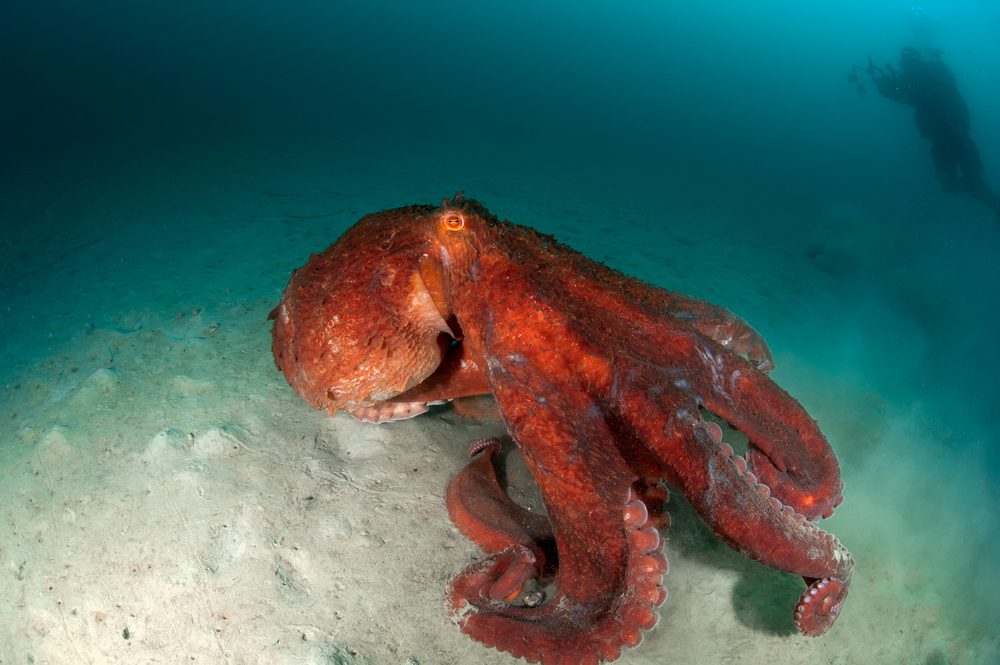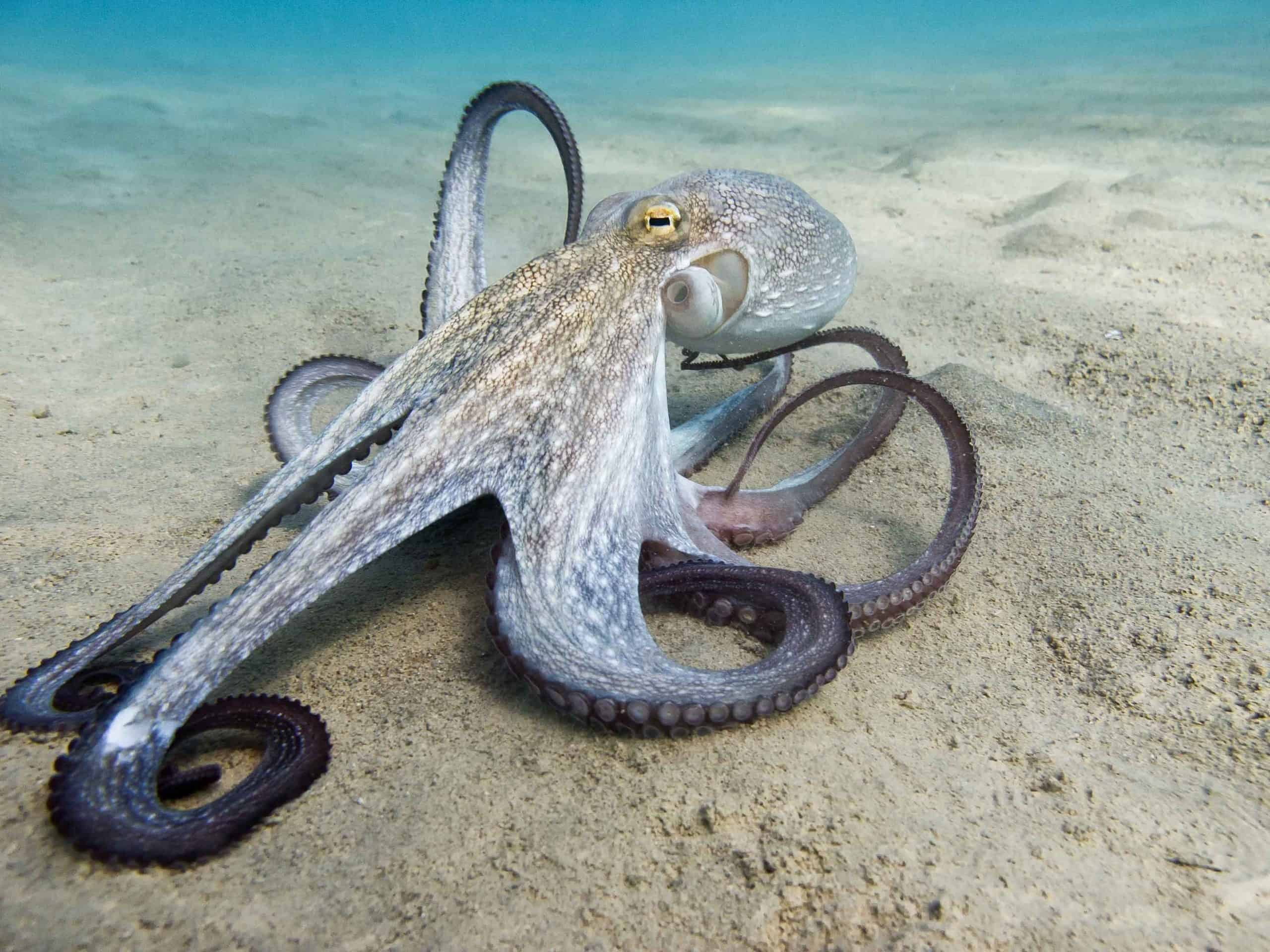Octopuses are both brilliant and fascinating creatures, with a name that means “eight legs” in Greek. They are some of the most intriguing forms of marine life on the planet, and their size can vary significantly.
From the smallest, measuring just 2 inches, to the largest, measuring a whopping 18 feet, octopuses come in a range of sizes.
You are reading: The 10 Largest Octopuses In The World
In this article, we will explore the ten largest octopuses in the world, examining their size, habitat, and unique characteristics. Join us on this journey to discover the incredible diversity of these fascinating creatures that inhabit our oceans.

The 10 Largest Octopuses In The World
Giant Pacific Octopus

The Giant Pacific Octopus (Enteroctopus dofleini) is the largest octopus species in the world, belonging to the genus Enteroctopus. They are found in the coastal North Pacific, along Mexico, the United States, Canada, Russia, Eastern China, Japan, and the Korean Peninsula.
These cephalopods can grow up to 15 feet or more in length and weigh about 150 pounds, but the largest individuals can be even heavier and longer.
The most enormous Giant Pacific Octopus ever measured was a staggering 30 feet long and weighed approximately 600 pounds. They are best adapted to cold, oxygen-rich water and can be found from the intertidal zone down to 2,000 meters (6,600 feet) .
Seven-Arm Octopus

The Seven-Arm Octopus (Haliphron atlanticus) is one of the two largest known species of octopus, along with the Giant Pacific Octopus.
Here are some interesting facts about the Seven-Arm Octopus:
– The largest specimen ever discovered had an estimated total length of 3.5 meters (11 feet) and a mass of 75 kilograms (165 pounds) .
– The seven-arm octopus is found in the Pacific and Atlantic oceans.
– Despite its name, the seven-arm octopus has eight arms, like all other octopuses. The “seven-arm” name derives from the fact that the hectocotylus, a specially modified arm used in egg fertilization, is coiled in a sac beneath the right eye. Due to this species’ thick, gelatinous tissue, the arm is easily overlooked, giving the appearance of just seven arms.
– The seven-arm octopus has a lifespan of about two years.
– This species is known to feed on jellyfish, as well as other cephalopods and crustaceans.
Overall, the Seven-Arm Octopus is a fascinating creature that continues to intrigue scientists and ocean enthusiasts alike.
Southern Giant Octopus
The Southern Giant Octopus (Octopus tetricus) is a species of octopus found in the waters around southern Australia and New Zealand.
Here are some interesting facts about the Southern Giant Octopus:
– This species can grow up to 16 feet in length and weigh up to 110 pounds.
– The Southern Giant Octopus is known for its ability to change color and texture to blend in with its surroundings, making it an expert at camouflage.
– They are carnivorous and feed on a variety of prey, including crabs, lobsters, and fish.
– The Southern Giant Octopus has a relatively short lifespan of only about two years.
– They have a unique mating behavior where the male octopus will insert a specialized arm called a hectocotylus into the female’s mantle cavity to fertilize her eggs.
– The Southern Giant Octopus is an important species for commercial and recreational fishing in Australia and New Zealand, and there are regulations in place to manage their populations.
Read more : Discover 6 Animals That Lurk Atop Black Mesa – Oklahoma’s Highest Point
Overall, the Southern Giant Octopus is a fascinating creature with unique characteristics and behaviors that continue to intrigue scientists and ocean enthusiasts alike.
North Pacific Giant Octopus
The North Pacific Giant Octopus (Enteroctopus dofleini), also known as the Giant Pacific Octopus, is a large marine cephalopod belonging to the genus Enteroctopus.
Here are some interesting facts about the North Pacific Giant Octopus:
– The North Pacific Giant Octopus is found in the coastal North Pacific, along Mexico, the United States, Canada, Russia, Eastern China, Japan, and the Korean Peninsula.
– This species can grow up to 14 feet in length and weigh up to 110 pounds.
– The North Pacific Giant Octopus is the largest octopus species, based on a combination of weight and arm span.
– They are best adapted to cold, oxygen-rich water and can be found from the intertidal zone down to 2,000 meters (6,600 feet).
– The North Pacific Giant Octopus is a highly intelligent creature that can solve puzzles and open jars to obtain food.
– They are carnivorous and feed on a variety of prey, including crabs, clams, and fish.
– The North Pacific Giant Octopus has a relatively short lifespan of only about three to five years.
– This species has a unique mating behavior where the male octopus will insert a specialized arm called a hectocotylus into the female’s mantle cavity to fertilize her eggs.
– The North Pacific Giant Octopus is an important species for commercial and recreational fishing in many areas, and there are regulations in place to manage their populations.
Overall, the North Pacific Giant Octopus is a fascinating creature with unique characteristics and behaviors that continue to intrigue scientists and ocean enthusiasts alike.
Common Octopus
The Common Octopus (Octopus vulgaris) is a mollusk belonging to the class Cephalopoda.
Here are some interesting facts about the Common Octopus:
– Octopus vulgaris is one of the most studied of all octopus species, and also one of the most intelligent.
– The Common Octopus has a worldwide distribution in tropical, subtropical, and temperate waters throughout the world, preferring the floor of relatively shallow, rocky, coastal waters, often no deeper than 200 meters (660 feet).
– This species can grow up to 9 feet in length and weigh up to 22 pounds.
– The Common Octopus is known for its ability to change color and texture to blend in with its surroundings, making it an expert at camouflage.
– They are carnivorous and feed on a variety of prey, including crabs, lobsters, and fish.
– The Common Octopus is normally solitary and territorial, making its home near other octopuses of similar size.
– This species has a relatively short lifespan of only about two years.
– The Common Octopus has a unique mating behavior where the male octopus will insert a specialized arm called a hectocotylus into the female’s mantle cavity to fertilize her eggs.
– Octopus vulgaris is one of the most common octopus species commercially fished for food and for the aquarium trade.
Overall, the Common Octopus is a fascinating creature with unique characteristics and behaviors that continue to intrigue scientists and ocean enthusiasts alike.
Mimic Octopus
The Mimic Octopus (Thaumoctopus mimicus) is a fascinating species of octopus found in the Indo-Pacific region.
Here are some interesting facts about the Mimic Octopus:
– The Mimic Octopus is known for its exceptional ability to impersonate a wide variety of other marine animals, making it a master of disguise.
– Like other octopuses, it uses its chromatophores to change its color and blend in with its background. However, the Mimic Octopus is unique in its ability to mimic the appearance and behavior of other animals, such as lionfish, jellyfish, sea snakes, shrimp, and crabs.
– This species prefers obscuring murky and muddy sea floors to blend in with its natural brown-beige coloring.
– The Mimic Octopus uses a jet of water through its funnel to glide over the sand while searching for prey, which typically includes small fish, crabs, and worms.
– Unlike other types of octopuses that prefer reefs as shelter, the Mimic Octopus is often found in river mouths and estuaries. This is because its ability to impersonate toxic animals puts it at less risk of predation in the open.
– In addition to mimicking mobile animals, the Mimic Octopus has been observed mimicking sessile animals such as small sponges, tube-worm tubes, or colonial tunicates.
– This species is a relatively recent discovery and continues to intrigue scientists and researchers with its unique abilities and behaviors.
Yellow Octopus
The Yellow Octopus (Enteroctopus zealandicus) is a large octopus species of the genus Enteroctopus, endemic to the waters surrounding New Zealand.
Here are some interesting facts about the Yellow Octopus:
– The Yellow Octopus is also known as the New Zealand Octopus.
– This species can grow up to at least 1.4 meters (4.6 feet) in total length, though few whole samples have been collected and this is only a guide.
– The Yellow Octopus has the distinctive characteristics of the genus Enteroctopus, including longitudinal folds on the body and large paddle-like papillae.
– They are carnivorous and feed on a variety of prey, including crabs, lobsters, and fish.
– The Yellow Octopus is an important prey species of the endangered New Zealand sea lion.
– The Yellow Octopus is relatively elusive and not much is known about its behavior and life cycle.
– This species is not commonly kept in aquariums, but some institutions have been successful in breeding them in captivity.
Overall, the Yellow Octopus is a fascinating creature that continues to intrigue scientists and researchers with its unique characteristics and behaviors.
Southern Red Octopus
The Southern Red Octopus (Octopus maya) is a species of octopus found in the tropical Western Atlantic Ocean, specifically in the waters around the Yucatán Peninsula in Mexico.
Here are some interesting facts about the Southern Red Octopus:
– The Southern Red Octopus is also known as the Mexican four-eyed octopus.
– This species can grow up to 20 cm (8 inches) in mantle length.
– Southern Red Octopuses vary in color from bright red to rust and have whitish suckers under their arms.
– They are known to feed primarily on benthic prey such as crustaceans, bivalves, fish, gastropods, other octopuses, and even birds.
– The Southern Red Octopus is an important species for commercial fishing in the Yucatán Peninsula, where it makes up 80% of the octopus catch.
– The parasite fauna of the Southern Red Octopus in southern Mexico remains unknown.
– The Southern Red Octopus is not commonly kept in aquariums.
Read more : Top 10 Animals With Camouflage So Good Theyre Basically Invisible
Overall, the Southern Red Octopus is a fascinating creature with unique characteristics and behaviors that continue to intrigue scientists and researchers.
East Pacific Red Octopus
The East Pacific Red Octopus (Octopus rubescens) is a species of octopus found in the shallow waters of the North American West Coast, from the southern Gulf of California to at least the Gulf of Alaska, and possibly in the western Pacific Ocean.
Here are some interesting facts about the East Pacific Red Octopus:
– The East Pacific Red Octopus is also known as the Pacific Red Octopus, Ruby Octopus, or Bull Octopus.
– This species lives in kelp forests in sandy and rocky areas, to a depth of 200 meters (656 feet).
– The East Pacific Red Octopus is a small species, growing up to 12-16 inches in length and weighing an average of 14 ounces.
– Like all octopuses, the East Pacific Red Octopus can change its color and texture, making its appearance highly variable. Color can vary from a deep brick red, to brown, to white, or mottled mixtures of the three.
– They are carnivorous and feed on a variety of prey, including crabs, clams, and fish.
– The East Pacific Red Octopus has a relatively short lifespan of only about two years.
– This species is known for its intelligence and problem-solving abilities, and has been studied extensively by researchers.
– The East Pacific Red Octopus is not commonly kept in aquariums.
Overall, the East Pacific Red Octopus is a fascinating creature with unique characteristics and behaviors that continue to intrigue scientists and researchers.
Dumbo Octopus
The Dumbo Octopus (Grimpoteuthis spp.) is a genus of pelagic cirrate octopods known for their ear-like fins, which extend from the mantle above each eye, resembling the title character of Disney’s 1941 film Dumbo.
Here are some interesting facts about the Dumbo Octopus:
– There are about 17 species recognized in the genus, and they are found in the deep sea, living at depths of at least 13,100 feet (4,000 m) below the surface.
– Dumbo octopuses are the deepest-living octopuses known, with some specimens captured or observed in hadal depths.
– They are naturally rare, and the deep sea is enormous, so these species have specialized behaviors to increase the likelihood that they can successfully reproduce anytime that they find a mate. Females apparently always carry eggs in different stages of development, and they are able to store sperm for long periods of time after mating with a male.
– Dumbo octopuses move by slowly flapping their ear-like fins, and they use their arms to steer. They are foraging predators and eat pelagic invertebrates that swim above the sea floor.
– Due to their preference for extreme depths, they are only very rarely captured in fishing nets and are probably not threatened by human activities.
– The Dumbo Octopus is not commonly kept in aquariums.
– The dozen or so species that make up Grimpoteuthis are called Dumbo octopuses because of the two large fins—one on either side of the mantle—that protrude like ears.
Overall, the Dumbo Octopus is a fascinating creature with unique characteristics and behaviors that continue to intrigue scientists and researchers.
FAQS
1. What is the largest octopus species in the world?
The Giant Pacific Octopus (Enteroctopus dofleini) is the largest octopus species in the world, with an overall length over 15 feet or more. They typically weigh about 150 pounds, but the largest individuals can be even heavier and longer.
2. What is the second-largest octopus species in the world?
The Seven-Arm Octopus (Haliphron atlanticus) is the second-largest octopus species in the world, with a maximum weight of about 165 pounds and a length of around eleven feet.
3. Where is the Southern Giant Octopus found?
The Southern Giant Octopus (Octopus tetricus) is found in the waters around southern Australia and New Zealand.
4. What is unique about the Mimic Octopus?
The Mimic Octopus (Thaumoctopus mimicus) is known for its exceptional ability to impersonate a wide variety of other marine animals, making it a master of disguise.
5. What is the habitat of the Dumbo Octopus?
The Dumbo Octopus (Grimpoteuthis spp.) is found in the deep sea, living at depths of at least 13,100 feet (4,000 m) below the surface.
6. Are any of these octopus species commonly kept in aquariums?
The Common Octopus (Octopus vulgaris) and the East Pacific Red Octopus (Octopus rubescens) are not uncommon in aquariums, but the other species on this list are not commonly kept in captivity.
Source: https://petstutorial.com
Category: Animals










